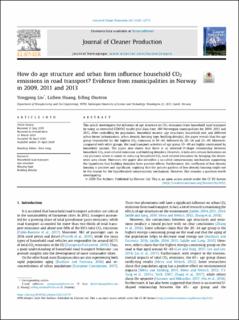| dc.contributor.author | Liu, Yongping | |
| dc.contributor.author | Huang, Lizhen | |
| dc.contributor.author | Onstein, Erling | |
| dc.date.accessioned | 2021-03-17T07:33:31Z | |
| dc.date.available | 2021-03-17T07:33:31Z | |
| dc.date.created | 2020-05-05T10:56:25Z | |
| dc.date.issued | 2020 | |
| dc.identifier.citation | Journal of Cleaner Production. 2020, 265, . | en_US |
| dc.identifier.issn | 0959-6526 | |
| dc.identifier.uri | https://hdl.handle.net/11250/2733794 | |
| dc.description.abstract | This article investigates the influence of age structure on CO2 emissions from household road transport by using an extended STIRPAT model plus data from 380 Norwegian municipalities for 2009, 2011 and 2013. After controlling for population, household income, age structures, household size, and different urban forms (urbanization, urban density, housing type, building density), the paper reveals that the age group responsible for the highest CO2 emissions is 50–69, followed by 20–34 and 35–49. Moreover, compared with other groups, the road transport activities of age group 35–49 are highly constrained by household income. The paper also shows that there is an inverted U-shape relationship between household CO2 road-related emissions and building densities. However, it indicates certain limitations on city planners when it comes to reducing household CO2 road-related emissions by bringing the downtown area closer. Moreover, the paper also identifies a so-called compensatory mechanism supporting the hypothesis that building densities have positive effects. Furthermore, the coefficient of low-density housing is positive and significant, implying that the private gardens of low-density housing might not be the reason for the hypothesized compensatory mechanism. However, this remains a question worth investigating. | en_US |
| dc.language.iso | eng | en_US |
| dc.publisher | Elsevier | en_US |
| dc.rights | Navngivelse 4.0 Internasjonal | * |
| dc.rights.uri | http://creativecommons.org/licenses/by/4.0/deed.no | * |
| dc.title | How do age structure and urban form influence household CO2 emissions in road transport? Evidence from municipalities in Norway in 2009, 2011 and 2013 | en_US |
| dc.type | Peer reviewed | en_US |
| dc.type | Journal article | en_US |
| dc.description.version | publishedVersion | en_US |
| dc.source.pagenumber | 16 | en_US |
| dc.source.volume | 265 | en_US |
| dc.source.journal | Journal of Cleaner Production | en_US |
| dc.identifier.doi | 10.1016/j.jclepro.2020.121771 | |
| dc.identifier.cristin | 1809418 | |
| dc.description.localcode | This is an open access article distributed under the terms of the Creative Commons CC-BY license, which permits unrestricted use, distribution, and reproduction in any medium, provided the original work is properly cited. | en_US |
| dc.source.articlenumber | 121771 | en_US |
| cristin.ispublished | true | |
| cristin.fulltext | original | |
| cristin.qualitycode | 2 | |

